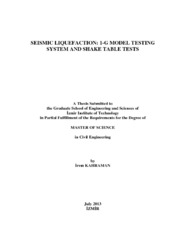Please use this identifier to cite or link to this item:
https://hdl.handle.net/11147/3575Full metadata record
| DC Field | Value | Language |
|---|---|---|
| dc.contributor.advisor | Ecemiş, Nurhan | en |
| dc.contributor.author | Kahraman, İrem | - |
| dc.date.accessioned | 2014-07-22T13:51:50Z | - |
| dc.date.available | 2014-07-22T13:51:50Z | - |
| dc.date.issued | 2013 | en |
| dc.identifier.uri | http://hdl.handle.net/11147/3575 | - |
| dc.description | Thesis (Master)--Izmir Institute of Technology, Civil Engineering, Izmir, 2013 | en |
| dc.description | Includes bibliographical references (leaves: 126-128) | en |
| dc.description | Text in English; Abstract: Turkish and English | en |
| dc.description | xviii, 137 leaves | en |
| dc.description.abstract | Soil liquefaction is a crucial, interesting and complex seismic problem. Previous earthquake records and computational modelings have given general information about liquefaction, but many questions, such as; effects of silt content on liquefaction phenomena have not been clearly answered yet. In this study, liquefaction phenomena in sands and silty sands were simulated by a large scale 1-g laminar box system. Three shake table tests were performed, where each test consisted of four shakes to analyze the initial-liquefaction and re-liquefaction phenomena. Instrumentations were used during shake table tests to measure laminate, soil response and settlement of ground. The soil deposit was prepared with different fines content using hydraulic filling method. Piezocone penetration tests (CPTu) were conducted, before and after each shake to determine the relative density of the soil model. Following results were found; Silty sands were found to possess more liquefaction resistance than uniform fine sands. Soils with rounded shapes were more susceptible to liquefaction, than angular grained soils. Required time to trigger liquefaction increased with fines content and depth of the soil sedimentation. Liquefaction resistance of each tested sand decreased from 1st to the 2nd shaking, despite increase in relative density. Relative density values increased with each shake. Despite the increase in relative density, liquefaction resistance decreased. Relative density values have decreased, when fines content increased, but despite decreased in relative density, liquefaction resistance increased. Ground settlement values after the shaking was more than during the shaking. Ground settlement values have increased with fines content of the soil model. | en |
| dc.language.iso | en | en_US |
| dc.publisher | Izmir Institute of Technology | en |
| dc.rights | info:eu-repo/semantics/openAccess | en_US |
| dc.subject.lcsh | Soil liquefaction | en |
| dc.subject.lcsh | Soil mechanics | en |
| dc.title | Seismic liquefaction: 1-G model testing system and shake table tests | en_US |
| dc.type | Master Thesis | en_US |
| dc.institutionauthor | Kahraman, İrem | - |
| dc.department | Thesis (Master)--İzmir Institute of Technology, Civil Engineering | en_US |
| dc.relation.publicationcategory | Tez | en_US |
| item.languageiso639-1 | en | - |
| item.fulltext | With Fulltext | - |
| item.openairecristype | http://purl.org/coar/resource_type/c_18cf | - |
| item.openairetype | Master Thesis | - |
| item.grantfulltext | open | - |
| item.cerifentitytype | Publications | - |
| Appears in Collections: | Master Degree / Yüksek Lisans Tezleri | |
Files in This Item:
| File | Description | Size | Format | |
|---|---|---|---|---|
| T001108.pdf | MasterThesis | 6.68 MB | Adobe PDF |  View/Open |
CORE Recommender
Page view(s)
86
checked on Jul 22, 2024
Download(s)
64
checked on Jul 22, 2024
Google ScholarTM
Check
Items in GCRIS Repository are protected by copyright, with all rights reserved, unless otherwise indicated.